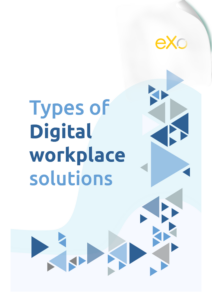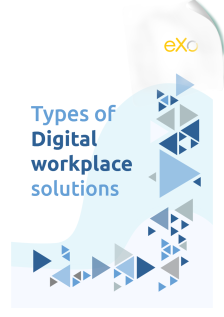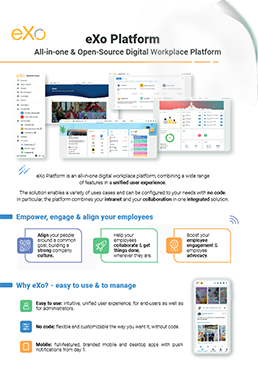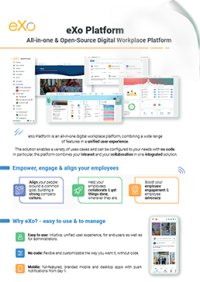


FREE WHITE PAPER
Digital workplace is a buzzword these days. Actually different people use it to mean different things. So what is a digital workplace?
Knowledge sharing is the backbone of any successful working experience.
If you asked both employees and business owners to identify the major challenges they are facing on a daily basis, access to information and various types of knowledge would be among the top answers.
In the absence of the right policies and tools, employees may find themselves switching between different platforms and apps to locate what they are looking for.
This can obviously impact productivity in the short term and leads to disengagement and voluntary turnover in the long term. More often than not, businesses lean towards implementing knowledge management systems to tackle these issues.

Sure, KMSs can bring a host of benefits to businesses, including increased productivity, a reduction in the time employees spend locating information, a reduction in duplicated knowledge, and enhanced onboarding and continuous learning – the list goes on.
However, a software without the right adoption plan, and more importantly the right culture, won’t lead to the desired results.
In this blog post, we will define the concept of a knowledge-sharing culture, walk through different types of knowledge within an organization and discover how you can create a knowledge-sharing culture in your workplace.
In a nutshell, a knowledge-sharing culture favours the free exchange of information and experiences between individuals, teams and entire organizations. It is viewed as an important pillar of the modern digital workplace and a competitive advantage for many businesses.
Those who succeed in creating a knowledge-sharing culture can guarantee a cooperative, knowledgeable and engaged workforce that can achieve the business’s overall objectives. However, those who don’t succeed may lag behind the competition in terms of both performance and attractiveness in the job market since workplace culture and self-development play an important role in the decision to join or leave a business.

Types of Digital workplace solutions
Digital workplace is a buzzword these days. Actually different people use it to mean different things. So what is a digital workplace?



With all the technologies available to handle and manage information, our perception of knowledge is now rather different to what it used to be for previous generations. Whenever we talk about knowledge, we automatically think of its explicit form. Explicit or codified knowledge is a collection of information such as employee handbooks or training materials that can be stored and organized within digital document libraries, learning management systems or large databases. Although effective in making company data easily accessible and retrievable, explicit knowledge is not experience based and therefore doesn’t give employees the option to learn by doing or from their peers’ experiences. On the other hand, tacit or implicit knowledge comprises a combination of skills and experiences that can’t be easily processed via, or stored within, a KMS.
The difference between explicit and tacit knowledge is fairly simple. For example, an employee handbook is a piece of explicit knowledge. Everything it contains can be understood simply by reading it. You don’t need to come late to the office each day to know it is against your company policy. However, learning how to speak in public or how to use a software, for example, requires you to experience the task first -hand. Sure, you can learn how to be a great speaker by reading books, but the next step is to do it yourself and ask people for personal advice.
Now that you have an idea about the types of knowledge that exist in the workplace, let’s discover how you can create a knowledge-sharing culture.
One of the main reasons that can contribute to the dispersion and loss of knowledge in the workplace is the reluctance of employees to share their experiences or ask for help.
Some employees might believe that their ideas can be stolen by their peers, while others might think asking for help would be negatively perceived by their management.
In both cases, it is important to remind employees that the only way to achieve business as well as individual objectives is to be open to sharing and learning.
Managers play an important role in conveying the benefits of knowledge sharing by taking a proactive approach. For example, they can demonstrate previous cases where the open exchange of ideas proved to be the difference between winning and losing a deal. They can also include the benefits in their employee handbooks and make sure to always communicate and ask their teams to voice their opinion.
Now that your employees understand the importance of knowledge sharing, the next step is to provide them with the right tools and best practices to facilitate the process. Obviously, a knowledge management system is your best bet for storing and organizing a large array of explicit information such as documents, wikis, etc.
Learning management systems are also widely adopted by businesses thanks to their ability to facilitate access to training materials through dedicated learning spaces. The wave of new technologies such as virtual reality and augmented reality took learning in the workplace to new heights by combining explicit and tacit knowledge.
Virtual worlds that represent an exact replica of real -life situations help employees to interact with their surroundings and become used to a specific layout.
Additionally, these new techniques focus heavily on building experiences through storytelling and complex branching scenarios.
Whenever new tools or policies are introduced into the workplace, it is crucial to provide users with the right training. That way, you can ensure the implemented solutions will be used to their full capacity.
Additionally, you can avoid any confusions or frustration associated with a lack of understanding of the solutions’ benefits and main features. In most cases, such confusion can lead to a low adoption rate and push employees to use their own solutions instead, which in turn leads to data loss and dispersion.
Stand-alone or built-in gamification and recognition systems have started to gain popularity recently as a way to engage communities and foster collaboration in the workplace.
Employees tend to be more willing to participate in knowledge-sharing initiatives if they are rewarded and praised for their contributions. For example, relaying useful information frequently and assisting peers with various tasks can both result in points awards. These points can be made visible on leaderboards, with employees ranked according to their actions.
Employees can also give and receive praise by their peers or managers for their contributions via kudos or personalized “thank you” messages.

eXo Platform : The Open-Source
Digital Workplace Platform
Download the eXo Platform Datasheet and discover all the features and benefits


Download the eXo Platform Datasheet and discover all the features and benefits
You will find here Frequently Asked Questions about collaboration with all the answers in one place.
Collaboration is “the situation of two or more people working together to create or achieve the same thing”.
Here are some definitions of digital workplace:
In order to effectively find the right type of collaboration for your business, you have to follow a strategic approach and answer three common yet critical questions: Where are we? Where do we want to be? And how to get there?
At the internal level, businesses try to encourage and seek to incorporate different forms of collaboration in the workplace to lay the foundations for teams to be able to work together with an aim to achieve higher levels of success.
Externally, businesses look to engage in collaborative actions to benefit from others’ expertise, to gather the opinions of their customer base and to get customers and other stakeholders more involved in the development of products and services.
Here are some of the benefits of collaboration in the workplace:
( Your e-mail address will not be published)
I am a product marketing specialist at eXo. My role is to assist marketing and sales teams in their operations and present our digital workplace solution to the world. I mainly blog about the latest tech trends, digital transformation, internal communication and how to navigate through eXo Platform.